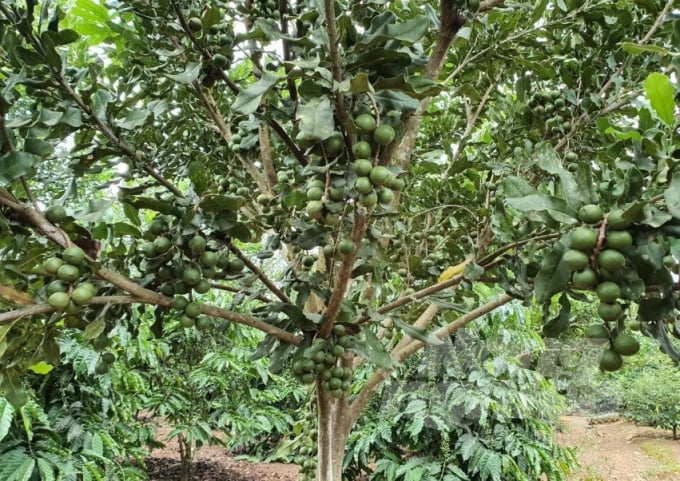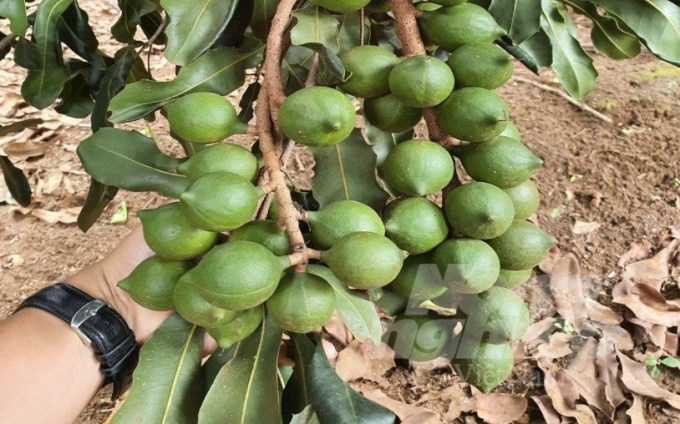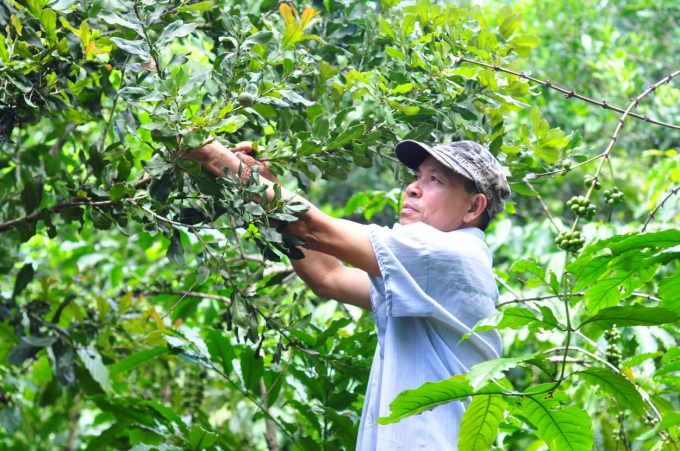May 16, 2025 | 22:19 GMT +7
May 16, 2025 | 22:19 GMT +7
Hotline: 0913.378.918
May 16, 2025 | 22:19 GMT +7
Hotline: 0913.378.918
Lam Dong is the province of different agro-ecological zones. In the 2005-2006 period, the province invested in many macadamia growing models through agricultural extension programs. The province also oriented farmers with large are of land to cultivate macadamia trees on trials. Thanks to the incentive policies of the province, the area of macadamia cultivation has expanded rapidly in a short time.

A macadamia farm in Lam Dong. Photo: TL.
After the Ministry of Agriculture and Rural Development (MARD) issued Decision No.1134 /QĐ-BNN-TCLN dated April 5, 2016 to approve macadamia development in the northwestern and Central Highlands regions, Lam Dong province set a master plan to grow macadamia trees on 2,500 ha by 2020. Based on the experiments during 10 years, Lam Dong had an overview of science, technology and economic, social and environmental impacts to base on to develop macadamia cultivation.
Lam Dong province issued Decision No. 1062/QĐ-UBND dated May 20, 2016 to approve a plan on macadamia development in the area in the 2016-2020 period with a vision towards 2030 which was considered as a legal fundamental for the long-term development of macadamia trees and hence Lam Dong is the first province to have a master plan to develop macadamia trees over the long term.
Thanks to good management and investment in science and technology, the province reached 4,863 hectares of macadamia trees by 2020 (accounting for 30% of the country's total crop area) of which 1,179 ha were producing nuts with 2,157 tons of dry macadamia. 4,722.4 hectares (72.4%) were mainly intercropped with coffee and tea and 140.9 hectares were purely cultivated on forest and agricultural land with a percentage of 62.5% and 37.5% respectively.

A fruitful macadamia tree of QN1 cultivar. Photo: TL.
Compared to 2,363.3 ha planned by the MARD, Lam Dong's area of macadamia cultivation reached 2.500 ha in the 2016-2020 period. The area increased by 3,883 ha compared to the year of 2016 and the output jumped by 1,847.6 tons.
In general, macadamia is suitable to a variety of ecological zones in Lam Dong. It grows well and brings high economic efficiency, not only contributing to poverty reduction but also make many households wealthier, creating jobs for farmers from ethnic groups in the remote areas and at the same time accelerating forest-land coverage
Lam Dong is one of the provinces growing macadamia very early. Since 2006 the province has made a master plan on macadamia cultivation, setting up appropriate tasks and solutions until 2020 with an orientation towards 2030. Accordingly, the province has focused on inter-cropping macadamia with coffee and tea to provide shade; developing processing industry in association with diversifying products, improving the quality and meeting domestic and international demand.
The People's Committee of Lam Dong province established a Steering Commission to develop Macadamia trees in the area in which Chairman of the provincial People's Committee played a role of the Head of the commission. Thanks to that it was convenient to give directions, steer operations and assign duties to its members who were leaders of the departments and relevant agencies. Therefore the program was implemented immediately and was deployed drastically and synchronously by authorities at all levels.

The models of inter-cropping coffee with macadamia are bringing positive results. Photo: Minh Hau.
The province issued many documents on planning and developing macadamia cultivation in the area for the 2016-2020 period with an orientation towards 2030, strengthening the management of macadamia seed quality in the area. Therefore the management by the State was enhanced during the implementation of the program.
The province also focused on helping organizations and individuals develop macadamia nut material areas meeting the standards of VietGAP, organic farming, diversifying processed macadamia products to respond to consumer tastes, moving towards building a brand for Lam Dong's macadamia nuts.
The province also instructed local people on the legal procedures to form cooperatives and cooperative groups to grow macadamia trees so as to cut production costs and create linkage chains for mass production of macadamia nuts; encouraging the development of OCOP products to promote advantages of unique local products; publicizing Lam Dong macadamia nuts through the domestic and international trade promotion events.

Seven-year-old macadamia tree of 246 cultivar. Photo: TL.
Additionally, Lam Dong has fostered the enterprises especially processing ones to participate in the linkage chains to boost demand and secure stable market access. The aim is to form five linkage chains of producing, processing and consuming macadamia nuts in the area.
Accordingly the costs for growing and establishing the linkage chains for sustainable macadamia production will be partially funded from the provincial and local budgets.
Lam Dong has researched and developed macadamia trees for nearly 15 years. So far it could be affirmed that the crop has a great potential for participating the global value chain. The below sharing can be seen as a lesson and a direction for sustainable macadamia development in Vietnam.
- Macadamia trees' requirements on the ecological environment are very strict so each locality needs to identify each ecological sub-region to choose the most suitable macadamia cultivars.
- This is a new crop hence each province has to establish a provincial steering commission for developing macadamia trees to give synchronous and effective directions to the departments, agencies and lower-level units.
- The provinces have to develop a master plan for macadamia development with a vision until 2030 and an orientation towards 2050, creating policies and legal framework to implement the program.

Right choice, secured quality and suitable cultivars play an important role in developing macadamia trees. Photo: TL.
- Regarding seed quality, this is a very important factor deciding 85% of the success of macadamia farming. There are three core issues to be focused on depending on each ecological zone.
- Seedlings: Only using grafted macadamia seedlings to ensure uniform growth rate and varietal purity. Seedlings must be bought from nurseries certified by competent authorities and meeting required standards.
+ Varieties used as rootstocks: H2 and 695 varieties
+ Varieties used as grafts: Because macadamia trees are cross-pollinated it's recommended that at least two varieties should be planted to ensure pollination and high yields however growing too many varieties are not recommended because it's difficult to care for trees and harvesting the nuts.
Depending on each ecological sub-region the priority can be given to six sets of varieties including: Set 1: QN1, 246, A16; Set 2: Daddow, 788, A16; Set 3: Daddow, 344, 842; Set 4: 842, 741, 816; Set 5: 741, 508, H2 and Set 6: 695, 842, 816
- It's necessary to inter-crop macadamia with other plants or macadamia can be purely cultivated depending on available land area and crop conditions to gain the highest economic efficiency.

Localities need to have a suitable planning and a long-term vision for macadamia development. Photo: Minh Hau.
- Depending on actual agricultural production each locality should develop appropriate policies to build momentum for sustainable macadamia development. It's necessary to include processing facilities in the strategy for developing macadamia from the beginning then attracting high-capacity macadamia processing plants to boost farmers to transfer the structure of crops and develop macadamia trees sustainably.
- Regarding implementation organization, all levels of government have to take drastic and synchronous action, especially in propaganda work so that farmers and enterprises can see clearly the economic, social and environmental benefits thereby they are determined to transform the structure of crop and choose appropriate cultivation techniques.
Although Macadamia in Vietnam is still a relatively new economic plant it has a great potential to grow. Therefore to develop macadamia trees sustainably it's necessary to make proper plans and have a long-term vision. In addition, using technologies for macadamia production and processing is needed.
In the near future it's important to set up hi-tech macadamia growing areas to apply advanced and uniform farming techniques to increase the yield and the quality of macadamia nuts.
Developing a model of intensive macadamia farming to transfer achieved results to farmers; step by step moving to organic macadamia cultivation to meet market demand in the future is needed.
Translated by Mai Tham

(VAN) Cold-barn systems efficiently manage environmental and temperature conditions, which aids in the prevention of respiratory diseases in pigs and protects them from the vectors that transmit African swine fevers.

(VAN) To tackle challenges, the project 'Addressing key technical bottlenecks in the grouper supply chain in Vietnam' has been underway since 2024.

(VAN) The project 'Disease-Resilient and Sustainable Cassava Production Systems in the Mekong Region', funded by the Australian Center for International Agricultural Research (ACIAR), is being implemented from 2024 to 2028.

(VAN) Data from 10,000 farming households will help professionalize production organization and support the implementation of the One Million Hectares Program for High-Quality, Low-Emission Rice Cultivation.

(VAN) FAO Director-General QU Dongyu marks International Day of Plant Health at NENA conference.

(VAN) Deputy Minister of Agriculture and Environment Hoang Trung affirmed that floriculture and ornamental plants are a growing industry that receives significant global attention.

(VAN) The three staple crops dominating modern diets – corn, rice and wheat – are familiar to Americans. However, fourth place is held by a dark horse: cassava.